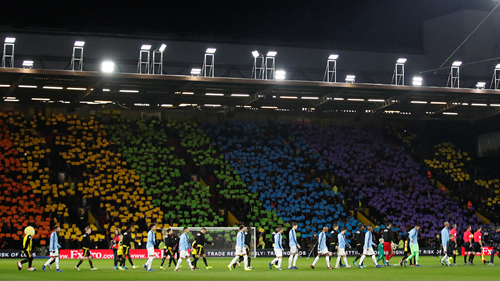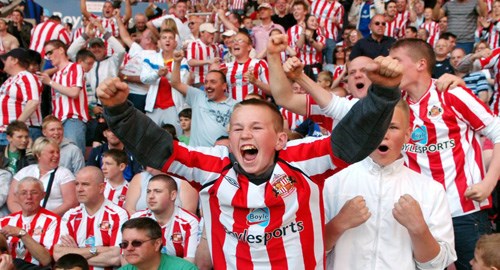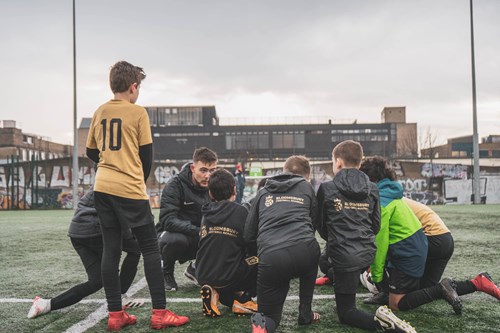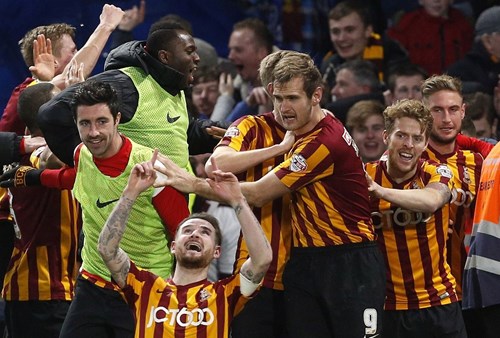With no openly gay players in England’s top four divisions, and only one man in Premier League history to publicly come out, an ongoing, outdated taboo clearly persists in men’s football. Extensive research has been conducted exploring the topic and, more importantly, what can be done for the sport to become more inclusive. UCFB Market Research and Insight Executive Adam Brenton summarises his dissertation on the subject...

Fans
Fans’ impact on other fans
The attitude towards homosexuality from fans in the game was found to be a large influence on how accepted many feel in football spaces. It was found that homosexual fans will stop going to football stadiums on a match day as masculine behaviour from fans and explicit comments made can leave them feeling excluded. These feelings are in fact agreed with by straight fans, who feel it is hard for homosexuals to get involved in all aspects of football due to a great deal of the social relationships built in football spaces being based on typically straight ideologies.
However, it was also found that the negative impact of the fans is dependent on how much homosexual individuals let such comments affect them. Some homosexual fans explained they aren’t phased about any homophobic comments from other fans. Perhaps this is a sign that a tolerance of homophobic abuse has been built in the game.
Fans’ impact on players
There is a similar impact from fans on the players’ sense of inclusion, and consequently their decision not to come out. While it was found that fans would be supportive of players if they were to come out, there was concern there is an initial embrace of a player’s homosexuality, yet it is felt the competitive nature of football will override this and make fans’ attitudes and behaviours change, using sexuality as an insult in game situations. It was also found the sense of exclusion is impacted through mob mentality. This was found to be a possible reason as to why no player has come out - such comments would influence a homosexual players’ sense of acceptance if they were to come out.
Progressive views of fans
However, there is scope for discussion that views within the game are changing as a younger, more inclusive set of fans take over. It is felt that views within general society are progressing to become more inclusive of sexual minorities and such views are therefore filtering into football. Moving forward, younger fans who are growing up to form the core of football’s fan base are being brought up in a more accepting society. It was also found that older fans currently show signs of hesitancy when accepting gay members into their group of fans, which can be attributed to the outdated views of previous generations. This again demonstrates how the age of the fan is a factor in their levels of tolerance towards homosexuality.

Media
It was also found that the media is an influence as to why a professional footballer has not yet felt they are able to come out as gay while playing. The responses found the media are obsessively pressing for a footballer to come out as gay, which dissuades footballers from wanting to come out. There is a feeling that no professional footballer wants to be the first to come out, due to the fact there would be a media eruption. No footballer wants this unfair attention on them from the media purely due to their innate sexuality.
The impact of social media was also raised as a clear contributing factor. It was found the potential for abuse to be so easily targeted at professionals via social media would dissuade footballers from coming out. It’s also found that social media is to blame for cancelling out the impact of increasing social acceptance of sexualities. While society has progressed in its views, social media gives people a platform to express their challenging views.
Teammates and culture
The influence of teammates was also still found to be a contributing factor to the sense of inclusion for homosexuals. Teammates could make comments they did not necessarily intend to be hurtful, yet these still alter the sense of inclusion the individual has in the football space as they feel those they share the space with do not agree with their sexuality. However, the research suggests that in the current football climate, the influx of culture can also have an impact. Culture and ethnicity are known to have an impact on senses of inclusivity (Birnir and Waguespack, 2011). The demographic of footballers (and hence teammates) in the UK has transformed in recent times, as the percentage of foreign players in the league has risen from 7% in 1992 to 60% in 2016 in line with the globalisation of the game (Shemla, 2016). It was concluded having teammates who originate from cultures or religions that are less accepting of homosexuality hinders inclusion.
Identity
It is also found that individuals are unlikely to feel included in football spaces if they do not identify with the norms and behaviours practised. This can refer to masculine or even misogynistic chanting and conversations about ‘typical’ male behaviours. This alienates those who do not identify with these behaviours. Therefore, in contrast, it was found that fans who do fit such demographics are more likely to feel included in football spaces. This again demonstrates the power of the fans, as it is ultimately the fans that set these behavioural and demographic norms.
Grassroots vs professional
It was clear from the interview responses that there is a better sense of inclusion created at grassroots level. People are playing football at this level for reasons relating to inclusion and socialisation, rather than professional reasons. This creates an accepting environment, in which a reciprocal relationship of inclusion is created so people are accepting of sexual minorities as their main reason of playing is also to be accepted.
Despite this feeling of embrace, there is still demand for gay network teams which have risen in prominence and numbers recently. The research found that these teams can offer homosexuals a way to feel included in the sport. Additionally, these grassroots teams provide not only footballing benefits, but wider social and networking benefits. This demonstrates a strong relationship between homosexuality, football and the wider community and also shows a difference between the grassroots and professional game as such attempts are not made at a professional level.

Discussion
It has ultimately arisen from the research that the environment created for homosexuals in football spaces is in the power of the fans which shows the power we have to construct a sense of place (Tuan, 1975). The research findings are supported by Dick (2009) who found seven in ten fans who have attended a match in the last five years have heard anti-gay language and abuse on the terraces which links back to the original literature review in which it was found football is associated with depictions of masculinity. This suggests football has not progressed in its attitudes towards homosexuality, which does not support what was found from my interviewee responses. This suggests the growth in the acceptance of homosexuality is just a perception created as people are more willing to talk about the issue, yet in reality this does not mean homophobic abuse stops.
The notion that fans also have a direct impact on professional players is supported by Dick (2009) who found three in five fans think anti-gay abuse from fans dissuades gay professional players from coming out. It is clear from the interviewees responses and Dick’s research there is a fear for homophobia when football fans are in large groups, which develops the point of Davis in McGowan (2014) that professional players have to consider the reaction from fans before making a decision to come out.
The research found such problems are irrelevant at grassroots level where there is a better sense of inclusion. This can be explained by Bailey’s (2007) theory that sport is primarily played at lower-scale level for the reason of social inclusion. Therefore, there is a simultaneous sense of confusion across literature and this research as to why grassroots gay network teams are required (Crafton, 2018). This is again further supported by Jones and McCarthy (2010: 169) who criticise these teams for adopting a new place and creating a “gay ghetto” rather than operating side by side with other teams.
Similar studies further prove the impact teammates have on professionals’ decision to come out. One in four fans think the reaction from teammates discourages players from coming out (Dick, 2009) and Crafton in Grounds (2018) states that while Britain as a country and society is progressive in its views, other cultures and religious beliefs present in changing rooms is a contributing factor as to why a professional may not feel he is able to come out.

Conclusion
It was found that football is traditionally a game entrenched with masculine values, which presents a barrier for football being inclusive to homosexuality. Influencing factors on this feeling of outsideness (Relph, 1976) is fans and the media, while players have the additional concern of teammates’ cultures. This is not the case at grassroots level however where teammates are more embracing of homosexuality due to it being practised for mainly social reasons. Therefore, the presence of gay network teams is found to be considered as preventing progression of the issue. Going forward, football as a social construct is always owned by the fans – as Jock Stein famously said, “football is nothing without the fans”. Therefore, it is argued it is up to the fans to set the change. However, following the success of Rainbow Laces, future progression is ultimately to be controlled by players as, in disagreement to Ashton et al (2018), it is found fans feel a player needs to come out for the issue to go any further making governing bodies efforts redundant.




















